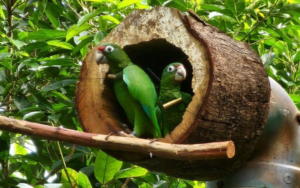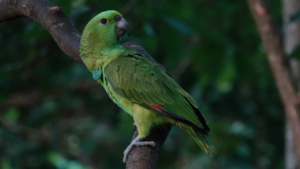
Two organizations, The Macaw Society and The Mesoamerican Society for Biology and Conservation, have come together to focus specifically on how to increase knowledge about releasing confiscated parrots back into the wild. They held their first conference in November 2023.
Don Brightsmith, and Gabriela Vigo-Trauco, PhDs from Texas A&M University, were the lead organizers of this conference. Here is a description of the current problem and the goals of the newly established Parrot Release Network in their own words.

“As you likely know, parrots are one of the most globally endangered groups of birds due to a mixture of illegal trade and habitat loss. As a result, over 50 species have been identified as potentially benefitting from captive breed and release programs. Additionally, thousands of illegally held parrots are confiscated and sent to rehabilitation centers and many are likely releasable.

Photo by Marisel López- USFWS
Fortunately, parrot release science is improving, but few scientists study the release process, and few practitioners publish their innovations. As a result, there is much we still need to learn and there is an urgent need to exchange information amongst the stakeholders.
Confiscated parrots can live for decades and quickly fill rescue centers requiring thousands of dollars for food and upkeep annually. This accumulation of birds can cause problems for conservation because many government officials do not confiscate birds and enforce wildlife laws if there is nowhere to put the confiscated birds, and enforcement failures often lead to increased poaching.
Global Mission Underway to Return Captive Parrots Home
Current IUCN guidelines add to the difficulties, as they communicate that all possible solutions of what to do with confiscated wildlife are undesirable, providing governments and other stakeholders little practical guidance on how to manage confiscated animals of non-threatened species. Unfortunately, releases are expensive and difficult, requiring long-term monitoring to gauge their effectiveness.

In addition, poorly executed release efforts can threaten animals and ecosystems through disease transmission, genetic pollution, and ecological disruption. As a result, these releases must be conducted appropriately. However, many release projects are either unaware of these new best practices or are unable to replicate them. As a result, there is a great need to improve both the theory and practice of parrot releases into the wild.
There is an urgent and immediate need to improve the methods of parrot release, document successes and failures, and make this information available to practitioners, governments, and academics alike. The objective of the November symposium was to bring together a diversity of actors in the field of psittacine release to present information on what works and what does not work, create a new network of parrot release experts and practitioners, facilitate discussion about how to create and disseminate information, and support new organizations interested in conducting responsible release projects.”
This month’s Lafeber grant goes to support this new conservation and information-sharing network with the hope that more parrots will once again live in the wild and not need to spend their days crowded into rescue centers or be subject to poaching due to the lack of adequate enforcement. You can learn more about the Macaw Society here (https://vetmed.tamu.edu/themacawsociety)

1 Comment